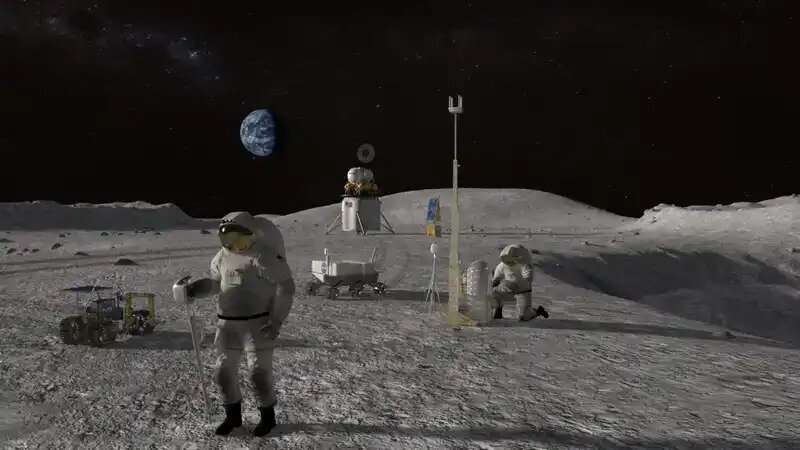There, they discover what tools and methods will work best for Artemis astronauts.
At NASA's Goddard Space Flight Center in Greenbelt, Maryland, field geologist and planetary scientist Kelsey Young serves as a science liaison to the exploration systems group within the Exploration ans Space Communication (ESC) projects division's Commercialization, Innovation, and Synergies (CIS) office. CIS shares Goddard's broad experience in areas like communications, miniaturization, and software development with other NASA centers, the government at large, and the private sector.
"Our weekly meetings are an important touchpoint between the engineering and science teams working in space exploration at Goddard," said Young. "The Goddard community is working together—along with other NASA centers and our academic and industry counterparts—to prepare to accomplish high priority science objectives during the Artemis era of lunar exploration."
Science instruments tested in analog environments include spectrometers that allow astronauts to identify the composition of lunar rocks and soil, or regolith. Magnetometers and gravimeters measure magnetic fields and local gravity. Laser ranging systems can help produce high-resolution maps of the topography. Ground-penetrating radar can probe for interesting underground features.
These instruments can sometimes be heavy or cumbersome, or not designed for space or field applications. NASA takes testing in analog environments as an opportunity to miniaturize and optimize them, to develop best practices for using them in scientific exploration, and to develop procedures for using these tools and the systems that support them.
"Many of the instruments we test are commercially available," said Young. "We determine the operational use for each tool and determine how astronauts could utilize their science data in real time."
There are several efforts across NASA focusing on different analog environments worldwide. Young works in a many of these environments, some of which are described below.
The Solar System Exploration Division's Goddard Instrument Field Team (GIFT), which Young co-leads, is a sustained investment in both planetary geology and astrobiology. GIFT tests new instruments in a variety of locations that mimic planetary surfaces across the solar system, particularly volcanic environments like those on the Big Island of Hawaii. Lava tubes are one area of particular interest, as they could potentially serve as habitats or radiation shelters on the Moon or Mars.
NASA's Remote, In Situ, and Synchrotron Studies for Science and Exploration (formerly RIS4E, now RISE2) also focuses on volcanic environments. RISE2, funded by the Solar System Exploration Research Institute (SSERVI), is led by Stony Brook University in Long Island, New York. They provide students with opportunities to get involved in analog testing as interns. Science, engineering, and even journalism students have made profound contributions to the effort as investigators and documentarians.
Young also works on the NASA Extreme Environment Mission Operations (NEEMO) team, led by NASA's Johnson Space Center. NEEMO sends groups of engineers, scientists, and astronauts on extended stays to Aquarius Reef Base, an undersea research station operated by Florida International University. For up to three weeks at a time, these aquanauts live and work underwater, simulating space exploration missions and testing equipment and operational concepts 62 feet below the surface of the water near a coral reef.
While NASA designs and conducts analog environment research to advance space exploration, the research has impacts far beyond space exploration.
"The measurements we take in these extreme environments not only helps us understand other planetary bodies, but can also help us learn about the Earth," said Young. "Our investments in analog environments turn out to have benefits for a wide variety of applications including technology development and terrestrial science."
Analog environment testing lays a strong foundation for the Artemis program. As NASA ventures to the Moon, Mars, and beyond, the tools tested in these environments will inform the instruments developed by NASA engineers for Artemis astronauts —tools that will make profound discoveries about the universe and push the boundaries of exploration.
Connections between scientists like Young and engineers in CIS' exploration systems group empower NASA to get the most out of analog testing opportunities. The synergies they find in their work allow NASA to discover more and explore further. When NASA scientists and engineers share their knowledge and expertise, there's no limit to what they can accomplish.
"We're so glad to have Kelsey and others working on these kinds of instruments," said CIS Exploration Integration Manager Mark Lupisella. "Providing Artemis astronauts with the instruments they'll need to perform advanced science on the lunar surface and eventually Mars will not only help us advance specific key areas of science, but will also help us find solutions to the exploration challenges of tomorrow."



